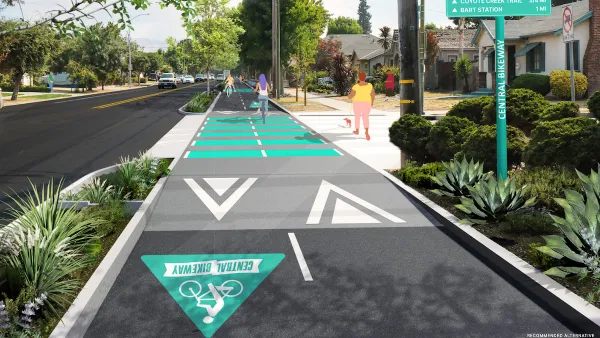Ridership on the city’s transit system has gone up by 20 percent since they eliminated bus fares in 2022.

Almost two years ago, Albuquerque eliminated fares on its public bus system. In a piece for Next City, Erin Rode outlines some of the impacts the free fare program has had on the city’s residents.
According to Rode, “Nearly 90% of Albuquerque’s bus riders have household incomes of less than $35,000 per year, and a similar percentage don’t have access to a vehicle.” City officials cite this as one reason why making transit affordable and accessible is “the first purpose of public transit.” Free fares allow people, particularly those who are unhoused, to get to medical appointments, access social services, go to work, and see family.“For other Albuquerque residents, free public transit serves as a lifeline, a vital mobility option when money is tight or other transportation falls through.”
Making transit free citywide also reduces the strain on nonprofit social service providers, some of whom spent their own resources providing bus passes for their clients.
Since Albuquerque first piloted free transit in 2022, ridership is up 20 percent. Previously, fare revenue only brought in roughly $3 million per year to an agency with a $67 million budget. Unlike other cities, which have rolled back Covid-era zero-fare programs, Albuquerque appears committed to keeping transit free.
FULL STORY: What Free Transit Looks Like in Albuquerque, Nearly Two Years After the City Eliminated Fares

Planetizen Federal Action Tracker
A weekly monitor of how Trump’s orders and actions are impacting planners and planning in America.

Silicon Valley ‘Bike Superhighway’ Awarded $14M State Grant
A Caltrans grant brings the 10-mile Central Bikeway project connecting Santa Clara and East San Jose closer to fruition.

Amtrak Cutting Jobs, Funding to High-Speed Rail
The agency plans to cut 10 percent of its workforce and has confirmed it will not fund new high-speed rail projects.

Oregon Approves Ambitious Framework for ’Microgrids’
Local energy “islands” within the larger power system ensure key facilities can remain online during emergencies and power outages.

A Historic Investment in LA County’s Parks and Open Spaces
Los Angeles County has launched its largest-ever competitive grant program, investing $58 million to expand park access, enhance climate resilience, and support community-driven projects in the areas that need them most.

San Diego Wins $14M for Affordable Housing
The funding comes via the state’s Regional Early Action Planning program and will help create close to 1,000 new housing units.
Urban Design for Planners 1: Software Tools
This six-course series explores essential urban design concepts using open source software and equips planners with the tools they need to participate fully in the urban design process.
Planning for Universal Design
Learn the tools for implementing Universal Design in planning regulations.
Caltrans
City of Fort Worth
New Jersey Institute of Technology
Mpact (founded as Rail~Volution)
City of Camden Redevelopment Agency
City of Portland
City of Laramie





























